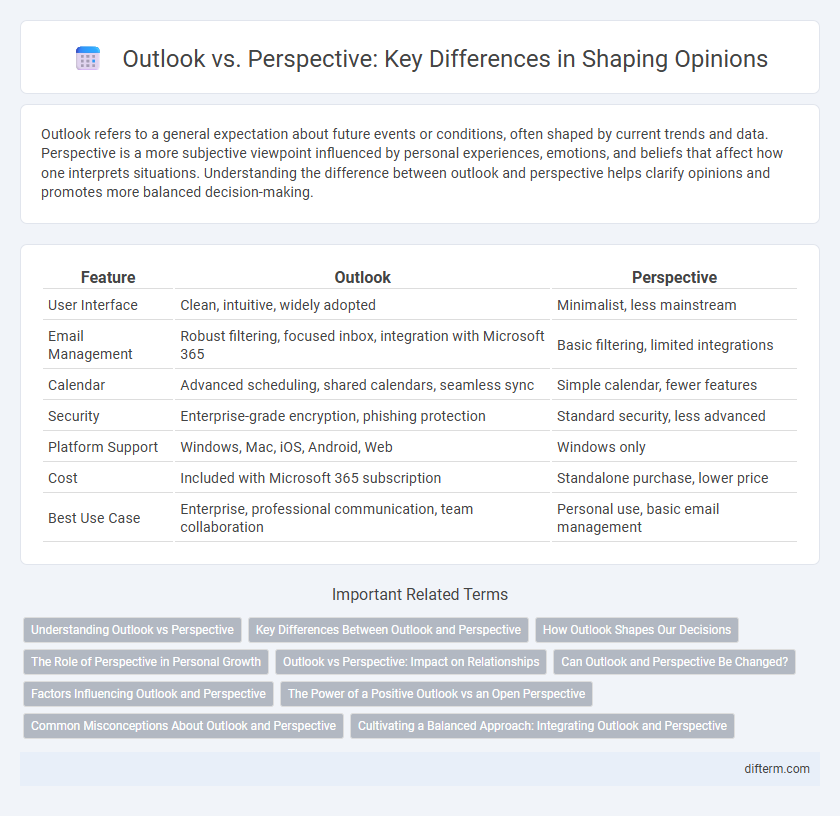Outlook refers to a general expectation about future events or conditions, often shaped by current trends and data. Perspective is a more subjective viewpoint influenced by personal experiences, emotions, and beliefs that affect how one interprets situations. Understanding the difference between outlook and perspective helps clarify opinions and promotes more balanced decision-making.
Table of Comparison
| Feature | Outlook | Perspective |
|---|---|---|
| User Interface | Clean, intuitive, widely adopted | Minimalist, less mainstream |
| Email Management | Robust filtering, focused inbox, integration with Microsoft 365 | Basic filtering, limited integrations |
| Calendar | Advanced scheduling, shared calendars, seamless sync | Simple calendar, fewer features |
| Security | Enterprise-grade encryption, phishing protection | Standard security, less advanced |
| Platform Support | Windows, Mac, iOS, Android, Web | Windows only |
| Cost | Included with Microsoft 365 subscription | Standalone purchase, lower price |
| Best Use Case | Enterprise, professional communication, team collaboration | Personal use, basic email management |
Understanding Outlook vs Perspective
Understanding the difference between outlook and perspective is crucial for accurate communication and decision-making. Outlook refers to a predicted or expected future scenario based on current data, while perspective is an individual's unique way of interpreting experiences shaped by beliefs and emotions. Clarifying these distinctions enhances clarity in discussions about future expectations and personal viewpoints.
Key Differences Between Outlook and Perspective
Outlook refers to a person's general attitude or anticipated future scenario, often shaped by experiences and external conditions, while perspective emphasizes an individual's viewpoint or interpretation shaped by personal beliefs and values. The key difference lies in outlook being more future-oriented and predictive, whereas perspective centers on present understanding and subjective assessment. Understanding these distinctions helps in appreciating how individuals approach situations either through expectation or interpretation.
How Outlook Shapes Our Decisions
Outlook influences decision-making by framing how we interpret situations and anticipate outcomes, guiding choices based on underlying beliefs and attitudes. A positive outlook encourages risk-taking and innovation, while a negative outlook may result in caution and avoidance. This cognitive framework fundamentally shapes our responses and strategies in both personal and professional contexts.
The Role of Perspective in Personal Growth
Perspective shapes personal growth by enabling individuals to reinterpret challenges and embrace learning opportunities. Unlike a fixed outlook, which often limits vision to current beliefs, perspective fosters adaptability and a deeper understanding of oneself and others. This dynamic viewpoint drives emotional intelligence and resilience, essential components for continuous self-improvement.
Outlook vs Perspective: Impact on Relationships
Outlook shapes how individuals generally view life and situations, influencing communication styles and emotional responses in relationships. Perspective provides the specific vantage point or interpretation during interactions, affecting conflict resolution and empathy between partners. Understanding the interplay between a person's outlook and perspective enhances emotional connection and mutual respect in relationships.
Can Outlook and Perspective Be Changed?
Outlook and perspective can indeed be changed through conscious effort and new experiences that challenge existing beliefs. Psychological studies show that mindset shifts often result from deliberate reflection, exposure to diverse viewpoints, and adaptive learning. Both outlook and perspective are dynamic cognitive constructs that evolve with personal growth and situational changes.
Factors Influencing Outlook and Perspective
Outlook and perspective are shaped by various factors including cultural background, personal experiences, and cognitive biases. Psychological influences such as mental health and emotional resilience also play a critical role in determining how individuals interpret and respond to situations. External elements like social environment, education, and media exposure further contribute to the formation of one's outlook and perspective.
The Power of a Positive Outlook vs an Open Perspective
A positive outlook fosters resilience by encouraging optimism and focusing on potential solutions, which can enhance motivation and overall well-being. An open perspective promotes adaptability by welcoming diverse viewpoints and new information, enabling more informed decision-making and personal growth. Combining both approaches maximizes emotional strength and cognitive flexibility, ultimately supporting success in complex and changing environments.
Common Misconceptions About Outlook and Perspective
Common misconceptions about outlook and perspective often confuse these terms as interchangeable, but outlook refers to a general attitude toward future events, while perspective encompasses a broader, more nuanced viewpoint shaped by experience and context. Many assume outlook is static, yet it can evolve with new information or changing circumstances. Understanding this distinction clarifies how individuals interpret situations and shape responses, improving communication and emotional intelligence.
Cultivating a Balanced Approach: Integrating Outlook and Perspective
Cultivating a balanced approach involves integrating both outlook and perspective to enhance decision-making and personal growth. Outlook represents one's general attitude toward future possibilities, while perspective provides the contextual understanding that shapes how those possibilities are interpreted. Combining a positive outlook with a broad, informed perspective fosters resilience and adaptability in navigating challenges.
Outlook vs Perspective Infographic

 difterm.com
difterm.com